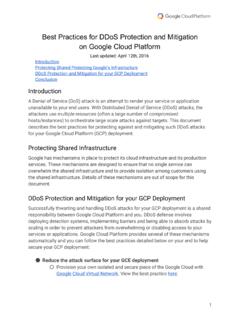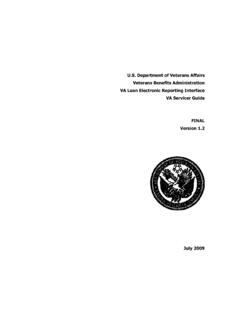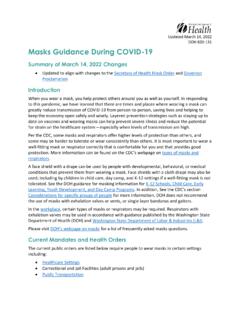Transcription of Gearbox Typical Failure Modes, Detection and Mitigation ...
1 Gearbox Typical Failure Modes, Detection and Mitigation Methods Shawn Sheng National Renewable Energy Laboratory/National Wind Technology Center AWEA Operations & Maintenance and Safety Seminar January 15 16, 2014. nrel /PR-5000-60982. nrel is a national laboratory of the Department of Energy, Office of Energy Efficiency and Renewable Energy, operated by the Alliance for Sustainable Energy, LLC. Outline Background Gearbox Typical Failure Modes Bearings Gears Lubricant Detection Techniques Real-time Periodic Mitigation Strategies Bearings Gears Lubricant 2. Background Gearbox Reliability Challenges Gearboxes do not always achieve their 20-year design life Premature Gearbox failures: Are widespread Affect most original equipment manufacturers (Most) are not caused by manufacturing practices, except grind temper and nonmetallic inclusions Gearbox largest contributor to turbine downtime and costliest to repair*.
2 * Sheng, S. (2013). Report on Wind Turbine Subsystem Reliability A Survey of Various Databases. June 2013. nrel /PR-5000-59111. 4. Gearbox Damage Gearboxes can fail in drastically different ways Data: 257 Gearbox damaged records Bearings: 70%; gears: 26%; and others: 4%. Observations: Both bearing and gear failures are concentrated in the parallel section Top Failure mode is high-speed shaft (HSS) or intermediate-speed shaft (IMS). bearing axial cracks Damage Bearings Gears Others Records Planetary 44 23 21. IMS N/A 34 9. 47. HSS N/A 123. Total 257 180 68 9. 5. Typical Failure Modes A Representative Configuration High-Speed High-Speed Stage Shaft Pinion Intermediate-Speed Annulus Shaft Gear Pinion Planet Planet Carrier Low-Speed Shaft Sun Gear Low-Speed Stage Intermediate-Speed Stage 7.
3 Typical Failure Modes: Bearings Macropitting Axial Cracks Recent Failure mode of significant proportions Most appear initiated with irregular white etching areas Manifests as axial cracks within the roller path Progresses to macropitting, split inner ring, or Denting/Point-surface- both origin (PSO) macropitting Fretting corrosion Scuffing False brinelling Photo Credits: Bob Errichello, GEARTECH, Johan Luyckx, Hansen Transmissions, Andy Milburn, Milburn Engineering, and Ryan Evans, Timken 8. Typical Failure Modes: Gears Subsurface initiated bending fatigue Scuffing (high-speed stage pinion). (due to nonmetallic inclusion, intermediate-speed stage pinion). Fretting corrosion (sun pinion) Micropitting/macropitting Photo Credit: Bob Errichello, GEARTECH.
4 9. Typical Failure Modes: Lubricant % Additives vs. Viscosity @ 40 C cSt D-445. R&O Mineral Oil Percent of New Oil Additive 510. Viscosity @ 40 C cSt 470. 430. 390. 350. % Electrooxidizable Additives 310. 270. Viscosity @ 40 C. 230. 190. New Oil Vis. = cSt 150. 110. 70. 30. 0 36 72108 138. Days Aged in Turbine Oil Stability Test D-943. Plot Credit: Bill Herguth, Herguth Laboratories 10. Typical Failure Modes: Lubricant (Cont.). Contaminations include: Wear debris Dust Foam Breathing of housing Air trapped in oil Not enough settling time Photo Credits: Bill Herguth, Herguth Laboratories, and Art Miller, EDFR. 11. Detection Techniques Real-Time Continuous Critical SCADA data trending: Temperature of high-speed stage bearing, targeting surface damage modes: pitting, scuffing, and so on Vibration analysis: Dedicated condition monitoring system with sensor bandwidth up to more than 10 kHz Effective for high-speed shaft, intermediate-speed shaft bearing, and gear surface damage modes: axial cracks, macropitting, scuffing, and so on Earlier Detection than oil debris analysis, but challenging to detect damage to planetary stage bearings and gears 13.
5 Periodic Oil sample analysis Six months or annual oil samples sent to dedicated laboratories for Typical physical and chemical property analysis: viscosity, additives depletion, and so on Debris element analysis may pinpoint failed components: bearings, gears, and so on Good for oil condition, not very good for conditions of bearings and gears Filter element analysis Old filter cartridge can be sent to dedicated laboratories for analysis when it is replaced with a new one Reveals what is typically missed in conventional oil sample analysis Identifies composition of wear debris and pinpoints damaged components: bearings, gears, and so on Reference Limits Analysis Results 14. Periodic (Cont.). Portable vibration sweep Sensors are similar to what are used by permanently installed vibration analysis systems Typically conducted during end-of-warranty (EOW) inspections targeting the same damage modes as permanently installed vibration systems Difficult to track down Failure history Borescope inspection Dedicated scope to inspect all accessible stages of gearboxes Normally triggered by abnormal symptoms on the gearboxes detected by other methods and used to confirm the damage, evaluate its severity level, and inform maintenance planning.
6 Damage modes observable on component surfaces, pitting, scuffing, and problems with the lubricant such as foaming Another scenario for conducting borescope inspections is during an EOW sweep Depending on Gearbox configuration, the inspection may not be thorough because of the difficulty in accessing and photographing certain components 15. Mitigation Strategies Bearing Axial Cracks Carburized instead of through hardened bearings1. For carburized bearings, the level of retained austenite is recommended to be at least around 20%1. Assembly temperature of bearing inner rings around 120 degrees Celsius2. Reduce transient event frequencies and their magnitudes Keep lubricant cool, clean, and dry 1.
7 Errichello, R.; Budny, R.; Eckert, R. (2013) Investigations of Bearings Failures Associated with White Etching Areas (WEAs) in Wind Turbine Gearboxes. Tribology Transactions, Vol. 56, No. 6, pp. 1069-1076, 2. Luyckx, J. (2011) Hammering Wear Impact Fatigue Hypothesis WEC/irWEA Failure Mode on Roller Bearings. Wind Turbine Tribology Seminar, Broomfield, CO. 17. Bearing/Gear Micropitting Grind/hone/polish gear teeth Superfinish, coat, or smooth bearing rings or elements Avoid shot-peened flanks Make hardest gear/bearing element as smooth as possible Make pinion 2 HRC points harder than gear Use oil with high micropitting resistance Keep lubricant cool, clean, and dry Use high-viscosity lubricant Operate at high speeds Coat teeth with phosphate, Cu, or Ag Run-in with special lubricant [w/o ZDDP (Zinc Dialkyl Dithio Phosphate)] at controlled loads Errichello, R.
8 (2011) Wind Turbine Gearbox Failures. Wind Turbine Tribology Seminar, Broomfield, CO. 18. Gear Scuffing Optimize gear geometry/accuracy Use nitrided steel Grind/hone/superfinish gear teeth Coat gear teeth with phosphate, Cu, Ag Use high-viscosity antiscuff lubricant Cool gear teeth with lubricant Run-in new gear-sets at reduced loads Errichello, R. (2011) Wind Turbine Gearbox Failures. Wind Turbine Tribology Seminar, Broomfield, CO. 19. Lubricant Contamination Pre-filter oil Run-in oil flushing Main loop filtration Offline loop filtration Breather Heat exchanger Periodic seal examinations Photo Credit: Don Roberts, DA Roberts LLC. 20. Summary Summary Wind turbine gearboxes can fail in dramatically different ways.
9 Improvements in reliability and availability have to take a holistic approach involving design, manufacturing, testing, packaging/shipping/handling, installation, operation, and maintenance. It also involves almost all stakeholders, Gearbox OEMs, turbine OEMs, owners/operators, research institutes, governmental agencies, and so on. Each Detection technique has its own advantages and limitations. The same is true for oil sample/filter element analysis, and end users need to come up with a solution that is the most economical and effective for their assets. Note that one solution for one plant may not apply to a different site. Tracking and knowing your fleet condition through various instrumentation and data mining are critical.
10 22. Gearbox Reliability Improved Wind Stats data from Germany: about 5,000 turbines, majorities megawatt- scale Both 2007 and 2012 data indicate the Gearbox as the highest downtime driver, but this was reduced by in 2012 with respect to 2007. Most subsystems show improved reliability and total downtime caused by all subsystems per turbine; in 2012 shows reduction with respect to 2007. 23. Thank You! Valuable reviews and comments from Bob Errichello are greatly appreciated! nrel 's contributions to this presentation were funded by the Wind and Water Power Program, Office of Energy Efficiency and Renewable Energy, Department of Energy under contract No. DE-AC02-05CH11231. The authors are solely Photo from HC Sorensen, Middelgrunden Wind Turbine Cooperative, nrel 17855.













